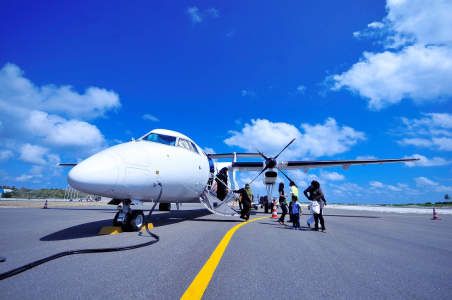Still love your comfy leggings on flights? Here’s why experts say it’s time to rethink them
By
Maan
- Replies 2
Comfort and convenience often guide our travel wardrobe choices—but some outfits could be doing more harm than good.
What many consider ideal in-flight attire might actually pose serious health and safety risks, especially on long-haul trips.
Now, experts are sounding the alarm on certain popular clothing choices that could turn your flight into a dangerous experience.
Comfort often comes first when deciding what to wear on a flight—but health and safety experts have warned that some of the most popular choices might actually be among the worst.
While many travellers regularly opt for leggings or tight jeans when boarding airlines like American Airlines, United or Southwest, these fashion staples have come under fire for posing potential health risks.
Dr Hugh Pabarue, a vein specialist from Metro Vein Centers, shared that wearing restrictive clothing while flying could have dangerous consequences.
‘The clothing we wear when we fly can significantly impact our circulation,’ he explained.
‘For example, tight clothing is not recommended. Wearing leggings and other restrictive garments such as skinny jeans that are too tight reduces blood’s ability to flow into and out of the legs.’
Remaining seated for long hours in cramped cabins can compound the issue, leading to discomfort, swelling and even more severe complications. Dr Pabarue warned that this lack of circulation could result in deep vein thrombosis (DVT)—a potentially life-threatening condition caused by blood clots forming in the legs.
‘Wearing clothes that are too tight can potentially lead to conditions like compartment syndrome or meralgia paresthetica, causing numbness, tingling, and severe leg pain,’ he added.
But beyond the medical risks, there were also safety concerns tied to what passengers wear in case of an in-flight emergency.
Aviation specialist Christine Negroni also cautioned against leggings specifically—not just because of their tight fit, but because of the materials they’re made from.
‘The issue with leggings is the nature of the material,’ she said.
‘You have a tight garment that is usually made from synthetic fibers, made from petroleum products, which is not something you want to wear on an airplane.’
‘The largest risk in a survivable air accident is fire.’
‘[The material of leggings] is going to get very hot, it will either melt on your skin or cause serious burns, and that becomes something that will impact your ability to escape the aircraft.
‘In other words, if you’re not damaged beyond [the] ability to exit, to get out of the airplane, then you might be affected by the fire.’
This echoed the warning issued by flight attendant Sille Rydell, who previously went viral after sharing her advice through social media on what *not* to wear while flying.
She listed several items that she discouraged passengers from wearing—including shorts, crop tops, flip flops and tights.
Her reasoning wasn’t limited to fire hazards either. Temperature also played a part.
‘Shorts or crop tops—ever felt the wrath of plane AC on bare thighs or on your naked belly? Brutal,’ she wrote.
Rydell explained that flip flops were also a poor choice, especially if passengers found themselves needing to run or evacuate in an emergency.
‘Flip flops—fine for the beach, not for running to your gate or emergency landings. Plus, I know you will take them off during the flight and walk barefoot.’
She added: ‘Tights [are] synthetic = flammable. Not what you want in case of fire [as the] fabric might burn into your skin.’
In a separate post back in April, a travel expert outlined what passengers should be wearing instead—highlighting breathable, non-restrictive layers that could be adjusted easily depending on temperature changes during travel.
Among her suggestions were slip-on sneakers, cotton dresses, T-shirts, lounge sets, and button-up shirts—ideal for dashing through terminals or curling up mid-flight at 34,000 feet.
So next time you reach for those comfy leggings before a flight, it might be worth considering not just your comfort—but your health and safety too.

Have you ever worn something on a flight that you later regretted—either for comfort or safety? Let us know your thoughts in the comments.
In a previous story, we took a light-hearted look at what your airport outfit might be saying about you—because fashion doesn’t retire, even at 30,000 feet.
For many senior Aussies who’ve spent decades perfecting their travel routine, it’s a fun reminder that style and practicality can still go hand in hand.
If you’ve ever wondered what your go-to flying outfit says about you, this one’s worth a chuckle.
Read more: Flight attendant spills what your airport fashion choices say about you
What many consider ideal in-flight attire might actually pose serious health and safety risks, especially on long-haul trips.
Now, experts are sounding the alarm on certain popular clothing choices that could turn your flight into a dangerous experience.
Comfort often comes first when deciding what to wear on a flight—but health and safety experts have warned that some of the most popular choices might actually be among the worst.
While many travellers regularly opt for leggings or tight jeans when boarding airlines like American Airlines, United or Southwest, these fashion staples have come under fire for posing potential health risks.
Dr Hugh Pabarue, a vein specialist from Metro Vein Centers, shared that wearing restrictive clothing while flying could have dangerous consequences.
‘The clothing we wear when we fly can significantly impact our circulation,’ he explained.
‘For example, tight clothing is not recommended. Wearing leggings and other restrictive garments such as skinny jeans that are too tight reduces blood’s ability to flow into and out of the legs.’
Remaining seated for long hours in cramped cabins can compound the issue, leading to discomfort, swelling and even more severe complications. Dr Pabarue warned that this lack of circulation could result in deep vein thrombosis (DVT)—a potentially life-threatening condition caused by blood clots forming in the legs.
‘Wearing clothes that are too tight can potentially lead to conditions like compartment syndrome or meralgia paresthetica, causing numbness, tingling, and severe leg pain,’ he added.
But beyond the medical risks, there were also safety concerns tied to what passengers wear in case of an in-flight emergency.
Aviation specialist Christine Negroni also cautioned against leggings specifically—not just because of their tight fit, but because of the materials they’re made from.
‘The issue with leggings is the nature of the material,’ she said.
‘You have a tight garment that is usually made from synthetic fibers, made from petroleum products, which is not something you want to wear on an airplane.’
‘The largest risk in a survivable air accident is fire.’
‘[The material of leggings] is going to get very hot, it will either melt on your skin or cause serious burns, and that becomes something that will impact your ability to escape the aircraft.
‘In other words, if you’re not damaged beyond [the] ability to exit, to get out of the airplane, then you might be affected by the fire.’
This echoed the warning issued by flight attendant Sille Rydell, who previously went viral after sharing her advice through social media on what *not* to wear while flying.
She listed several items that she discouraged passengers from wearing—including shorts, crop tops, flip flops and tights.
Her reasoning wasn’t limited to fire hazards either. Temperature also played a part.
‘Shorts or crop tops—ever felt the wrath of plane AC on bare thighs or on your naked belly? Brutal,’ she wrote.
Rydell explained that flip flops were also a poor choice, especially if passengers found themselves needing to run or evacuate in an emergency.
‘Flip flops—fine for the beach, not for running to your gate or emergency landings. Plus, I know you will take them off during the flight and walk barefoot.’
She added: ‘Tights [are] synthetic = flammable. Not what you want in case of fire [as the] fabric might burn into your skin.’
In a separate post back in April, a travel expert outlined what passengers should be wearing instead—highlighting breathable, non-restrictive layers that could be adjusted easily depending on temperature changes during travel.
Among her suggestions were slip-on sneakers, cotton dresses, T-shirts, lounge sets, and button-up shirts—ideal for dashing through terminals or curling up mid-flight at 34,000 feet.
So next time you reach for those comfy leggings before a flight, it might be worth considering not just your comfort—but your health and safety too.
Key Takeaways
- Tight clothes like leggings and skinny jeans may restrict blood flow and increase the risk of serious conditions like DVT.
- Synthetic fabrics used in leggings can melt or cause burns during an in-flight fire, affecting evacuation chances.
- Flight attendants warned against wearing shorts, crop tops, tights and flip flops due to both fire risk and exposure to cold temperatures.
- Experts recommended loose, breathable layers like T-shirts, cotton dresses and slip-on shoes for safer, more practical travel.
Have you ever worn something on a flight that you later regretted—either for comfort or safety? Let us know your thoughts in the comments.
In a previous story, we took a light-hearted look at what your airport outfit might be saying about you—because fashion doesn’t retire, even at 30,000 feet.
For many senior Aussies who’ve spent decades perfecting their travel routine, it’s a fun reminder that style and practicality can still go hand in hand.
If you’ve ever wondered what your go-to flying outfit says about you, this one’s worth a chuckle.
Read more: Flight attendant spills what your airport fashion choices say about you








